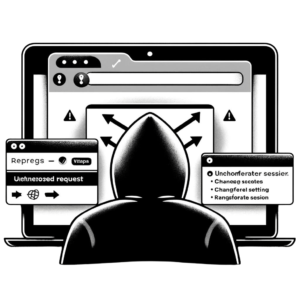Understanding Web Application Penetration Testing
Testing the security of your website is very important to make sure your online information stays safe. Web application penetration testing is a way to do this by pretending to be a hacker and finding any weak spots in your website that could be used by bad people. One example of a type of attack that this testing can help prevent is called CSRF (Cross-Site Request Forgery).
CSRF (Cross-Site Request Forgery) attacks happen when a harmful website tricks a person’s browser into sending a request to a web service that the person is logged into, without them knowing. Attackers can use this to do things like change account details or make purchases without permission.
By conducting detailed tests on web applications, experts in security can find and fix vulnerabilities related to CSRF (Cross-Site Request Forgery). They do this by adding security features like anti-CSRF tokens, same-site cookie settings, and checking data input carefully. By being aware of the risks and taking steps to prevent CSRF attacks, companies can keep their private information safe and make sure their users feel secure.
What are CSRF Attacks?
CSRF (Cross-Site Request Forgery) is a sneaky type of cyber attack. In this attack, a bad actor tricks a user into sending requests to a website that the user trusts. The user might not even realize they are sending these requests, and this can result in harmful actions being carried out without the user knowing. CSRF attacks are dangerous because they take advantage of the trust between a user and a website.
During web application penetration testing, it is crucial to detect and prevent CSRF attacks to ensure the security of the application. Detecting CSRF vulnerabilities involves analyzing the application for any insecure endpoint that does not require proper authentication or authorization. Preventing CSRF attacks can be done by implementing techniques such as using anti-CSRF tokens, validating and sanitizing user input, and implementing secure coding practices.
By learning about CSRF attacks and how they happen, people who work in web security can better protect their apps from these harmful threats. This helps keep user information safe and ensures the app runs smoothly.
How CSRF Attacks Work: Mechanics & Examples
Mechanics of CSRF Attacks
CSRF (Cross-Site Request Forgery) attacks are a common vulnerability in web applications that can have serious consequences if left undetected. Understanding the mechanics of CSRF attacks is crucial for web application penetration testers to effectively detect and prevent such threats.
At the core of a CSRF attack is the exploitation of a user’s authenticated session on a website. Attackers craft malicious requests that are disguised as legitimate actions, tricking the victim into unknowingly executing them. By leveraging the trust established between a user and a website, CSRF attacks can lead to unauthorized transactions, data manipulation, or account takeovers.
One of the key characteristics of a CSRF attack is its stealthy nature. Since the malicious requests originate from the victim’s browser with their credentials, they often go unnoticed by traditional security measures like firewalls or intrusion detection systems. This makes CSRF attacks a potent weapon for cybercriminals looking to bypass security defenses and compromise web applications.
To detect and prevent CSRF attacks, penetration testers employ techniques such as implementing anti-CSRF tokens, validating the Referer header, and utilizing same-site cookie attributes. By actively testing for CSRF vulnerabilities and implementing robust security controls, organizations can fortify their web applications against these insidious threats.
Examples of CSRF Attacks
Cross-Site Request Forgery (CSRF) is when a bad website tricks your browser into doing things on another site without your permission. This can lead to things like stealing your money, taking your personal information, or hacking into your accounts. Here are a few common ways these attacks happen:
1. Unauthorized Fund Transfers: An attacker can create a malicious website containing a hidden form that instructs the user’s browser to transfer funds from their bank account to the attacker’s account without the user’s knowledge.
2. Profile Changes: A CSRF attack can manipulate a user’s profile settings on a website, such as changing their email address or password, leading to potential identity theft or unauthorized access.
3. Social Media Hijacking: By exploiting CSRF vulnerabilities, attackers can post malicious content on a user’s social media account, potentially damaging their reputation or spreading malware.
4. Unauthorized Data Access: Attackers can trick users into unknowingly leaking sensitive information, such as personal details or login credentials, by exploiting CSRF vulnerabilities.
It’s important for website developers and security experts to be alert and put in place the right security measures to stop CSRF attacks. This can include things like using special tokens or adjusting cookie settings. Doing routine tests can also find and fix security problems before they are taken advantage of by bad actors.
Detecting CSRF Attacks with Penetration Testing
Common Vulnerabilities That Lead to CSRF Attacks
CSRF (Cross-Site Request Forgery) attacks are a common threat to web applications, exploiting vulnerabilities that allow attackers to perform unauthorized actions on behalf of authenticated users. Understanding the common vulnerabilities that lead to CSRF attacks is crucial for web application penetration testing in order to detect and prevent such malicious activities.
One way hackers can launch CSRF attacks is by taking advantage of a security gap where user input isn’t checked carefully. This allows them to send fake requests to the server, tricking it into doing things it shouldn’t.
Another vulnerability is insecure direct object references, where sensitive data or functionality is exposed to attackers. By manipulating object references in requests, attackers can exploit this vulnerability to perform unauthorized actions.
Additionally, inadequate anti-CSRF token implementation can also lead to CSRF attacks. Without proper anti-CSRF tokens or when tokens are not validated correctly, attackers can forge requests and bypass security mechanisms.
Web application penetration testers should thoroughly assess these vulnerabilities during security assessments to identify potential CSRF attack vectors and recommend mitigation strategies to prevent these attacks. By understanding and addressing these common vulnerabilities, organizations can strengthen their web application security and protect against CSRF threats.
Penetration Testing Techniques for CSRF Detection
It’s really important to test web applications to find and prevent vulnerabilities like CSRF attacks. CSRF is when a bad guy tricks a user into doing things on a website without their permission. Finding and stopping these attacks is essential to keep user information safe and make sure the website works correctly. Penetration testing is a key way to find and fix CSRF problems.
One common method used in penetration testing for CSRF detection is to simulate a malicious attack by crafting specially designed HTTP requests to manipulate user sessions. This helps security professionals understand how the web application handles such requests and whether it is vulnerable to CSRF attacks. Additionally, analyzing the application’s use of anti-CSRF tokens and session management mechanisms can uncover potential weaknesses that attackers could exploit.
By using tools like Burp Suite or OWASP ZAP, security teams can scan for CSRF vulnerabilities in web applications more easily. These tools help identify ways that hackers could trick web applications into performing unauthorized actions. Regularly testing for CSRF vulnerabilities is important for keeping web applications secure and protecting users’ sensitive information from being stolen.
Preventing CSRF Attacks
Security Policies and Procedures to Prevent CSRF
In order to keep web applications safe from CSRF attacks, it is important to have strong security rules in place. These attacks happen when a bad actor tricks a user into doing things they didn’t mean to while using a web app they are already logged into. To stop this from happening, companies should have strict security protocols in place.
A really important way to protect against CSRF attacks is to use anti-CSRF tokens in forms and requests. These tokens are special codes created by the server and added to each request. When the tokens are checked, web applications can make sure that the request is real and not fake. It’s also helpful to have good session management controls, like ending sessions after a certain amount of time with no activity or when you log out, to reduce the chances of CSRF attacks.
Regular security checks, training for developers and users, and monitoring web traffic are important steps to detect and prevent CSRF attacks. By being proactive and vigilant in implementing security measures, organizations can protect their web applications from CSRF vulnerabilities and improve their overall cybersecurity.
Technological Measures for CSRF Prevention
When testing web applications, it’s important to focus on preventing CSRF attacks. These attacks happen when a bad website tricks your web browser into making a request to a different website where you’re already logged in, which can lead to unauthorized actions being taken without your knowledge. To stop CSRF attacks, web developers can use different tools and techniques.
One way to protect against CSRF attacks is by using CSRF tokens. These tokens are special codes created for each user and included in every request sent to the server. By checking the token with each request, the server can make sure the request is real and not a CSRF attack.
Additionally, developers can utilize SameSite cookies to prevent CSRF attacks. SameSite cookies restrict the browser from sending cookies in cross-origin requests, thus reducing the risk of CSRF attacks. Implementing Content Security Policy (CSP) headers can also help mitigate the risk of CSRF attacks by controlling which external resources can be loaded on a website.
By using these technology tools in web apps, companies can improve their protection against CSRF attacks, which helps make their websites more secure for users.
Revisiting the Importance of Web Application Security
In the world of web security, it’s important to learn about and protect against CSRF attacks to keep your online accounts safe. CSRF, short for Cross-Site Request Forgery, is when a hacker tricks a website into thinking a user is sending a legitimate request, allowing them to do things on the site without permission. To protect against these types of attacks, websites can use techniques like CSRF tokens and SameSite cookie attributes. By staying informed and strengthening your defenses against these vulnerabilities, you can better protect your information online.
Key Takeaways and Best Practices
It’s important to test your website for vulnerabilities to protect it from harmful CSRF attacks. Make sure your website uses special tokens to check that user requests are legitimate and to stop unauthorized activities. Also, be sure to check and filter any input from users to prevent hackers from inserting harmful code. Keep your website up-to-date and fix any security issues that could be used by cybercriminals. Regularly check and test your website’s security to find and fix any weak spots in its protections. Stay aware of new cyber threats and security methods to keep your website safe.
